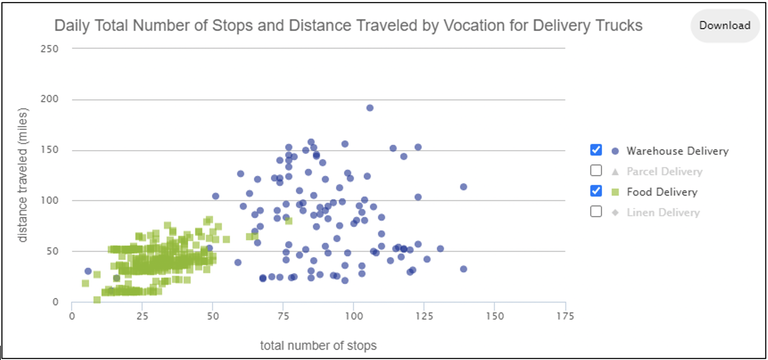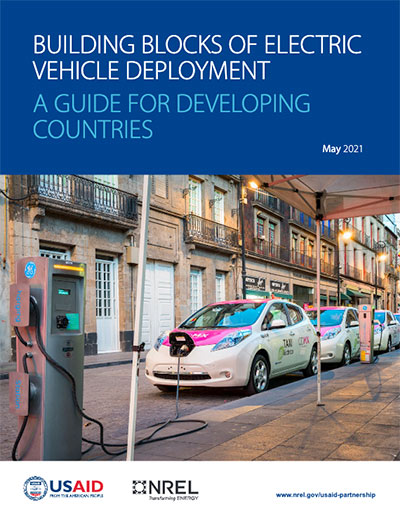Data Collection and Management
Summary for Decision Makers
Data curation and management helps identify the potential benefits of vehicle electrification and enables well-designed strategies to scale EV deployment in a targeted manner
There are measurable attributes of a transportation system that can help to indicate: (1) the best way to improve general transportation efficiency and quality for a given region, (2) the potential benefits of a transition to electric mobility for various types of vehicles/applications, and (3) the most effective instruments and approaches for transitioning to electric mobility. These attributes are often quantified by the key data sets listed in this section, which we organize into two categories:
Foundational Data
Foundational data is multipurpose data useful for defining the fundamentals of a transportation system.
- Transportation Fuel Use
- Can be used for multiple purposes, including 1) a metric for the energy efficiency of a transport system, 2) input to estimate emissions and air quality impacts from transport system, 3) a metric for energy security and resiliency calculations, and 4) a metric for estimating the increased electricity demand that electrifying transportation would add to the power system under various deployment scenarios.
- Vehicle Stock
- Generally, includes the make, model, vehicle type, and model year of every vehicle registered in a country. Can be used to determine how many vehicles might be replaced with comparable and available EVs and support fleet-specific strategies.
- Vehicle Kilometers Traveled
- Reports the kilometers that motorized vehicles travel on an annual basis. Can be used for multiple purposes, including an indicator of the amount and type of infrastructure used to support the travel, a reflection of how “motorized” a country’s transportation system is, and an indication of average fuel economy of various vehicle categories.
Specialized Data
Specialized data is useful for identifying the potential benefits of electrification, the best vehicles to electrify, and the best instruments to use when pursuing electrification.
- Mode of Travel
- Describes trips that are made by walking, biking, scooter, microtransit, mass transit, taxi, transportation network companies, carpools, and more. Can be used to determine how to allocate resources to support the most travelers in the most economical or environmentally friendly way. Can be useful to break this data down by age, gender, income, and trip type to enable resource allocation in an equitable manner.
- Access to Home Charging
- An important indicator for how convenient it will be for EV owners to recharge. Robust data sets on capability to charge at home are rare so this must often be approximated by other data such as number of houses with garages and car ports or share of buildings that are detached and semi-detached houses.
- Gasoline Prices
- Can be useful for assessing the likelihood that EVs will have favorable economics in each country and when determining if EV purchase incentives are needed to catalyze a market, and what magnitude.
- Electricity Tariffs
- An important factor in EV life cycle cost comparisons because of their impact on operational costs. In addition, some rate structures can influence what equipment can be used economically, when it can be used economically, and what impact it will have on the grid.
- Drive Cycle Profiles
- Define the distances driven, stops and starts, acceleration patterns, and geographical travel patterns of specific vehicles. These profiles, along with climate data that can impact battery range, are used to determine which vehicles would best be replaced by EVs, what the most appropriate equipment is (in terms of vehicle range and optimal EVSE placement), and what the economic payback of EV investment may be.
- Electric Generation Mix
- Shows what portion of the electricity is generated by various fuels. This is critical data to have when determining the emissions-related benefits of EV adoption in each area.
- Geospatial Data
- Many Geographic Information System (GIS) data files, including zoning, traffic volume maps, demographic data maps, and utility feeder maps can be valuable when planning where to locate new EV charging infrastructure.

Summary of Key Transportation Data Valuable for Electrification Efforts
|
Data Set |
Purpose/Use |
Source |
Probable Keeper |
Alternatives |
|
Transportation fuel use |
Defines potential economic and environmental benefits of EVs |
Fuel taxes |
Ministry of Energy |
Calculate from VKT and fuel economy |
|
Vehicle stock |
Helps prioritize vehicles to electrify |
Vehicle registration |
Ministry of Transportation |
Calculate from vehicle imports and expected life |
|
Vehicle Kilometer Traveled (VKT) |
Helps compare electrification with other strategies of increasing transport efficiency |
Traffic counts |
Ministry of Transportation |
Extrapolate from another country/city based on population density or GDP |
|
Mode of travel |
Prioritizes vehicles to electrify and compares with other strategies of increasing transport efficiency |
Transportation survey |
Ministry of Transportation |
Extrapolate from another country/city based on population density |
|
Access to home charging |
Indicates how convenient charging will be for population |
Housing survey or real estate databases |
Ministry of Housing, private real estate websites |
Proxies such as detached house type |
|
Gasoline price |
Indicates potential economic benefits of EVs |
Retail prices |
Ministry of Energy |
Transportation fuel excise taxes |
|
Electricity tariffs |
Indicates potential economic benefits of EVs, charging equipment, and impact on utility |
Posted tariffs |
Utility |
Ministry of Energy, International Energy Agency |
|
Drive cycle profiles |
Helps determine which vehicles are suitable for EVs and what equipment is needed |
Telematics and geolocating devices |
Fleet managers |
Fleet DNA |
|
Geospatial data |
Helps determine where EVSEs should be located |
Local governments |
Local governments |
None |
|
Electricity generation fuel mix |
Defines potential economic and environmental benefits of EVs |
Electric utility |
Electric utility |
Regulator of Utility or Ministry of Energy |
Additional Resources
Electric Vehicle Supply Equipment: Tariff Design Support to the Lao PDR (NREL 2020)


